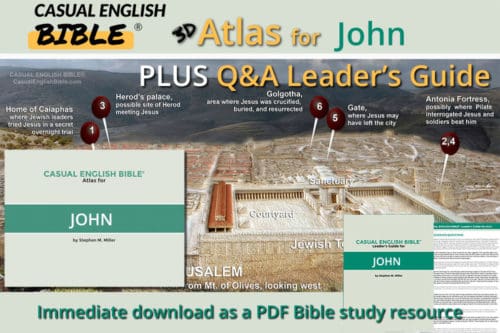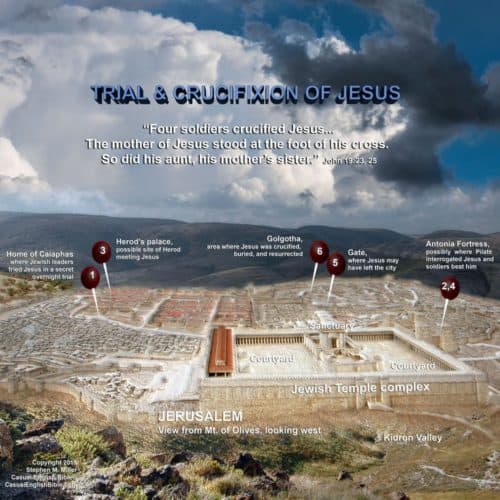John 20
Jesus, alive again and talking
Mary Finds an Empty Tomb
1Early on Sunday morning, while it was still dark, Mary Magdalene went to the tomb. She saw that it was open. Someone had moved the stone that covered the entrance. 2So she took off running back to Simon Peter and the disciple Jesus loved. [1] She told them, “They took our Lord out of the tomb. We [2] don’t have any idea where they put him.”3So Peter and the other disciple took off running to the tomb to check this out. 4They started running together, but the other disciple ran faster than Peter and he pulled ahead. He got to the tomb first. 5He bent down to look inside. He saw the strips of linen lying there in place. He didn’t go inside.
6When Simon Peter got there, however, he didn’t hesitate. He walked right inside the tomb. He saw the strips of linen lying there. 7But the face cloth that had covered the head of Jesus wasn’t lying with those strips of linen. Someone had rolled it up neatly and set it off to the side. 8The other disciple stepped into the tomb and saw this too. He believed something wonderful had happened. [3]
9Neither of the two realized that the Bible said Jesus had to rise from the dead. [4] 10The disciples went back to where they were staying.
Through Tears, Mary Sees Jesus
11Mary stayed. She stood outside the tomb crying. She was still crying when she bent down to look inside the tomb. 12She saw two angels sitting where the body of Jesus had been laid. One sat where Jesus’s head had rested. The other sat at the foot.13They asked Mary, “Ma’am, why are you crying?”
She said, “Someone has taken the body of my Master, and I don’t know where they put him.”
14After she said that, she turned around and saw Jesus standing right there in front of her. She didn’t realize it was him.
15Jesus spoke to her. “Dear woman, why are you crying? Who are you looking for?”
She thought he was the gardener, [5] so she said, “Sir, if you are the one who carried his body away, please tell me where you put him. I’ll take care of him.”
16Jesus simply said, “Mary.” She turned to him and spoke one word in Hebrew, “Rabboni.” [6] It means “Teacher.”
17Jesus told her, “Don’t hang on to me. You need to let me go. I still have work to do before ascending to the Father. [7] Go give this message to the disciples: ‘I’m ascending soon. I’m going back to my Father and your Father, to my God and your God.’”
18Mary went to the disciples and told them, “I have seen the Lord!” She delivered the message Jesus gave her.
Jesus Visits the Disciples
19Later that day, on Sunday evening, the disciples were staying inside a house. They had locked the doors because they were afraid of the Jewish leaders. Suddenly, there stood Jesus. He was right inside the house with them. He said, “Peace to you.”20After Jesus said this, he showed them his hands and his side. The disciples went ballistic with joy when they realized it was the Lord. 21Then he repeated himself. He said, “Guys, peace to you. The Father sent me. Now I’m sending you.” 22Then Jesus breathed on them and said, “Receive the Holy Spirit. [8] 23If anyone sins and you forgive them, it’s done—they’re forgiven. But if you don’t forgive them, it’s not done—they’re not forgiven.”
Thomas, the Show-Me Disciple
24One of the 12 disciples missed out on all of this because he wasn’t there when Jesus came. The disciple was Thomas, nicknamed the Twin. 25The other disciples told him, “We saw the Lord!”But Thomas said, “Okay, fellows, before I believe that I’m going to have to see the nail marks in his hands, stick my fingers into those nail wounds, and put my hand into his side.”
26Eight days later he got his chance. The disciples were in the house. Thomas was there too. With the doors locked, Jesus suddenly showed up standing right there in the middle of the group. He said, “Peace to you.” 27He turned to Thomas and said, “Okay, fellow, take a real close look at my hands. Touch them with your fingers. Then I want you to reach out your hand and put it into my side. Stop doubting. Believe.”
28Thomas said, “You’re my Lord and my God!”
29Jesus said, “You believe in me because you see me standing right here in front of you. God is going to honor the people who believe in me even though they don’t see me.”
Why This Gospel Exists
30Jesus did many other miraculous signs that proved who he was. They aren’t recorded in this book, but the disciples saw them. 31What is recorded in this book is here to help you believe that Jesus is the Messiah, the Son of God—and that by putting your trust in him, you can have a life that never ends. [9]Footnotes
The unidentified disciple seems to be the same one to whom Jesus entrusted the care of his mom (John 19:26-27). See also the footnote at John 13:23.
“We” may refer to other women who were with Mary (Matthew 28:1; Mark 16:1; Luke 24:10).
The Greek text says only that the disciple “saw and believed.” But when the writer of John’s Gospel uses the word “believe,” it seems to mean complete trust, authentic faith. Some scholars say that in the context of this Gospel, the writer was suggesting that the unidentified disciple believed this was another sign proving that Jesus was who he said he was. This Gospel is well known for its seven signs, or miracles, which illustrate that Jesus was the divine Son of God. For the signs, see the footnote for John 2:11.
A contender for such a prophecy: Psalm 16:10-11.
The tomb was in a garden (John 19:41).
Rabboni is pronounced (rah-BONE-eye). A version of “rabbi.”
These two lines keep Bible scholars guessing. A more literal translation: “Don’t hold on to me, because I haven’t ascended to the Father yet.” Another account of Jesus and Mary in the garden indicates that Mary and other women with her “rushed over to him, dropped to the ground, and started hugging his feet in worship” (Matthew 28:9). Some scholars say that it doesn’t make much sense to suggest that it’s wrong to touch Jesus before he has gone back to heaven, but it is okay to touch him after he’s gone–when it’s impossible to touch him physically. One possible explanation is that Jesus is telling Mary not to get attached to him or not to get used to having him around or not to try holding him back from wrapping up the work he needs to finish before he returns to the Father.
It’s hard to imagine Jesus going up to each disciple, blowing into the man’s face, and telling him to receive the Holy Spirit—even though wind will be associated with the Spirit’s arrival (Acts 2:2). But the image, whether literal or figurative, sounds very much like what was going on in the Creation story. “The LORD God made a man from the dust of the ground and blew into his nostrils the breath that brought him to life” (Genesis 2:7). One suggestion some scholars make is that just as God blew the breath of life into human beings (whether literally or figuratively), Jesus blew the breath of eternal life into the disciples, through the gift of the Holy Spirit. This did not necessarily mark the beginning of God’s new creation, launched by the resurrection of Jesus after he conquered death. But it may have marked the beginning of humanity’s role in God’s new creation.
Many scholars say the Gospel of John ended here, originally. The word choices and writing style in John 21 are quite a bit different from those of the earlier 20 chapters.
Discussion Questions
- 1
When people buried Jesus on Friday, they wrapped him in strips of cloth laced in myrrh and aloe, which is sticky. When Mary Magdalene went to the tomb on Sunday, it was empty, with the “strips of linen lying there in place” (John 20:6). What do you think that detail implies, if anything?
- 2
When Peter and “the other disciple” (John 20:8), possibly John, saw the empty tomb, the other disciple “believed something wonderful had happened” (John 20:8). That seems odd. Why wouldn’t he have thought someone stole the body?
- 3
Why can’t the Gospel writers get their story straight? Matthew says there were two women, Mary Magdalene and the other Mary, who saw one angel who glowed “like a burst of lightning” (Matthew 28:1, 3). Mark says three women went to the tomb of Jesus and saw a young man in a white robe (Mark 16:1, 5). Luke says there were several women who saw two men wearing clothes that had a dazzling shine (Luke 23:55; 24:1, 4). John says Mary Magdalene was alone, and that she saw two white-robed angels (John 20:11-12).
- 4
Jesus said something odd to Mary Magdalene. What do you make of the more literal translation, “Don’t hold onto me because I haven’t ascended to the Father yet” (John 20:17)?
- 5
What do you think the disciples of Jesus thought happened to the body of Jesus after Mary told them that the tomb was empty and “I have seen the Lord!” (John 20:18)?
- 6
How do you react to John’s reporting that Jesus was able to suddenly show up inside a house in which disciples had “locked the doors because they were afraid of the Jewish leaders” (John 20:19)?
- 7
Jesus says he’s sending the disciples on a mission, as the Father had sent him. Then he added, “If anyone sins and you forgive them, it’s done—they’re forgiven. But if you don’t forgive them, it’s not done—they’re not forgiven” (John 20:23). It’s not clear what Jesus meant by that. How do you take it?
- 8
Thomas missed out on seeing Jesus on Easter Sunday. He had to wait eight days. He apparently spent that time doubting what disciples told him about Jesus. He may have thought they saw a vision or got hold of some bad fish. Should we think less of Thomas because of his doubting?
- 9
LIFE APPLICATION. People say extraordinary things about Jesus today. Some say they see him in visions and near-death experiences. Some say they have heard him speak to them. In light of how Jesus gently chastised Thomas for doubting something extraordinary the disciples told him about Jesus, should we give credence to reports of Jesus sightings today?







